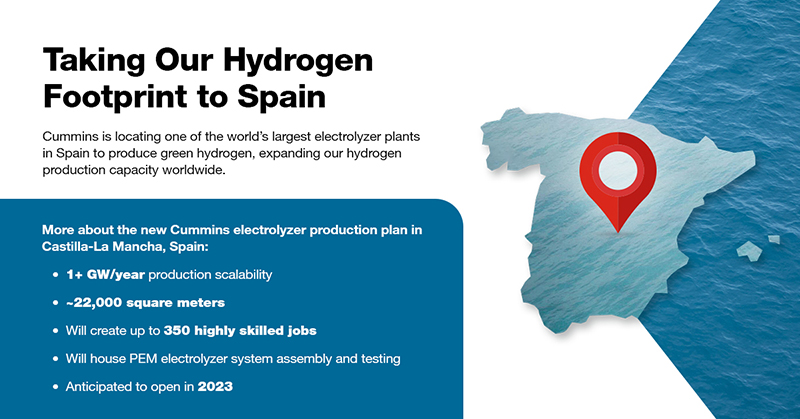Why Cummins selected Spain to expand its footprint for hydrogen generation
By Cummins Inc., Global Power Technology Leader

Cummins is locating one of the world’s largest electrolyzer plants for the production of green hydrogen in Spain. The 22,000-square meter facility will produce the world’s largest electrolyzer systems, with an initial production capacity of 500 MW/year and is scalable to more than 1 GW/year.
A site selection search is underway within Castilla-La Mancha, Spain, with the facility expected to open in 2023.
So, why Spain?
Government Support
Spain’s government is committed to accelerating clean hydrogen production through its hydrogen roadmap. Cummins’ new electrolyzer plant will help the country make strides towards its goal of 4 GW of electrolyzer capacity by 2030.
Large Hydrogen Market
With this focus on shifting to hydrogen, Spain offers a large domestic market for hydrogen, both for current industrial and agriculture customers, as well as future mobility and other applications. The country’s goals include ramping up hydrogen-powered bus systems, light and heavy vehicles and commercial rail lines.

Positive Economics
Solar costs in Spain have been dropping and are now among the lowest in Europe. This provides a competitive advantage for green hydrogen, both domestically and for potential export to the rest of Europe and beyond.
Workforce Poised for Innovation
With one of the largest economies in the European Union, Spain’s robust technical and manufacturing workforce is a great home for expanded hydrogen production and innovation.
Spain offers an ideal environment to expand Cummins’ hydrogen production capacity, while supporting their renewable energy goals through our leadership in alternative power technologies. Together, we can further decarbonization and accelerate the hydrogen economy.
Learn more about our plans to build one of the world’s largest electrolyzer facilities in Spain.
Author Profiles

Cummins Inc., Global Power Technology Leader
Cummins Inc., a global power leader, is committed to powering a more prosperous world. Since 1919, we have delivered innovative solutions that move people, goods and economies forward. Our five business segments—Engine, Components, Distribution, Power Systems and Accelera™ by Cummins—offer a broad portfolio, including advanced diesel, alternative fuel, electric and hybrid powertrains; integrated power generation systems; critical components such as aftertreatment, turbochargers, fuel systems, controls, transmissions, axles and brakes; and zero-emissions technologies like battery and electric powertrain systems and electrolyzers. With a global footprint, deep technical expertise and an extensive service network, we deliver dependable, cutting-edge solutions tailored to our customers’ needs, supporting them through the energy transition with our Destination Zero strategy. We create value for customers, investors and employees and strengthen communities through our corporate responsibility global priorities: education, equity and environment. Headquartered in Columbus, Indiana, Cummins employs approximately 70,000 people worldwide and earned $3.9 billion on $34.1 billion in sales in 2024.